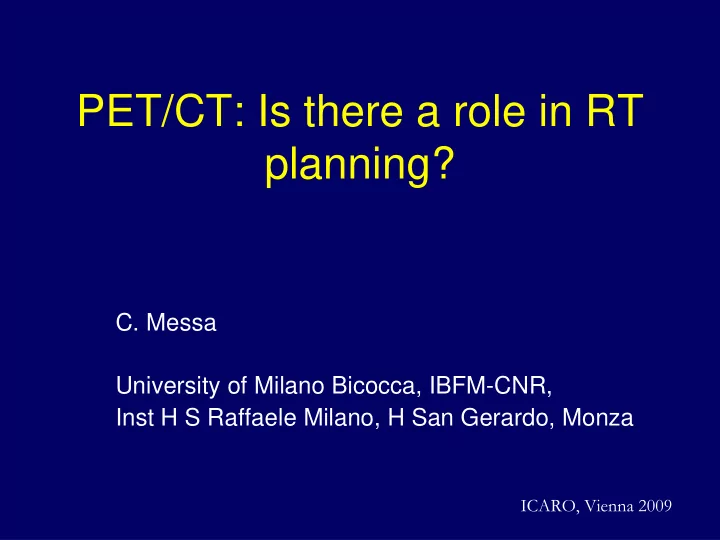

PET/CT: Is there a role in RT planning? C. Messa University of Milano Bicocca, IBFM-CNR, Inst H S Raffaele Milano, H San Gerardo, Monza ICARO, Vienna 2009
PET/CT in RTplanning • Decide for RT ‘curative’ treatment • Decide for RT treatment type • Assess response and prognosis
Decide for RT treatment: patients selection PET/CT with 18F-FDG (11C-Choline for prostate cancer) • STAGING (NSCLC, H&N, OESOPHAGEAL, CERVIX, LYMPHOMA) • RE STAGING (ALL ABOVE PLUS PROSTATE CANCER)
M.A. 73 yrs 16/9/05 18F-FDG CT Left lung cancer candidate to RT PET-CT HSR - Milano
11 C]Choline [ 11 C]Choline- -PET/CT: total body study PET/CT: total body study [ Local recurrence LN M HSR Milan
[ 18 F]FDG-PET M staging Author Tumor Site Sens Spec Arulampalam (2004) Colon Liver 100% 91% Gallowitsch (2004) Breast Various 97% 82% Hellwig (2001) Lung Adr gland 96% 99% Pieterman (2000) Lung Various 82% 93% Bury (1998) Lung Bone 92% 98% Unknown mts mts identified identified by by PET : PET : up up to to 20 20% of % of cases cases * * Unknown * Lardinois D et al. NEJM 2003
Decide RT treatment type • The PET-based GTV (‘Biological Target Volume’) • The boost
PET/CT-based GTV ( � GTV ) Atelectasia + Effusion Tumor C.G., 53 aa Lung Cancer 18-10-02 HSR Milano
PET/CT-based BTV ( � GTV ) PET/CT CT TOMOTHERAPY TREATMENT PLAN CT-based TT PET/CT-based TT HSR Milano
FDG-PET : GTV/PTV variations SITE N° studies Variation Lung 13 20%-70% H&N 4 17%-58% Cervix 2 20%-25% Grosu AL . Strah Onk 2005;181:483-499
How to contour FDG avid lesions 90% 70% 60% 50% 45% Visual, SUV-based,Thresholding, Background cut-off, source/background algorithms McManus et al, radioth and oncol, 91:85-94, 2009
Organ and Lesion Motion Moving Target Static Target
Standard planning oesophagus volume ( 30.8 cc ) Left lung 4D PET/CT planning volume (12.2 cc) � 60% Right lung heart marrow
Dose escalation on GTV (PET+) FDG PET volume FDG + � SIB approach � Dose escalated to 69 Gy � Acute tox comparable to a similar group of patients without dose escalation on GTV
Assess treatment response • Prediction of response • Monitoring therapy • Assess response after therapy
Alternative PET oncological tracers [ 11 C]Choline • Membrane function [ 18 F]FET / [ 11 C]MET • Amino acids metabolism [ 18 F]FLT • Proliferation ⎨ [ 18 F]FMISO [ 18 F]FAZA • Hypoxia [ 64 Cu]ATSM [ 18 F]Annexin V • Apoptosis [ 18 F]RGD peptide • Angiogenesis
Cervical Cancer : : Survival vs. 60 Cu-ATSM Uptake 1 1 T/M < 3.5 Progression-Free Survival .8 .8 Overall Survival T/M < 3.5 .6 .6 Overall .4 .4 T/M > 3.5 T/M > 3.5 .2 .2 P = 0.015 P = 0.0005 0 0 0 5 10 15 20 25 0 5 10 15 20 25 Time after Therapy Time after Therapy (Months) (Months) Dehdashti et al., Int J Radiat Oncol Biol Phys, 2003; 55:1233
PET/CT during RT (70 Gy in 35 days) Basal T = 0 SUV max : 15 50 Gy T= 25 gg Δ SUV: - 49% post RT T = 90 gg Δ SUV: - 61% HSR Milano
PET/TC AFTER 3 mo. End of RT 11-5-2006 PET/TC BASAL, 25 gen 2006 MMG, 48 yrs, breast ca (T2,N2) mastectomy RT CT 2002, lombalgia in 2005
After 4 months post-TT 67.2 Gy in 28 fractions Case 2: Common iliac nodes Pre-TT Pre-TT
Conclusion: PET/CT in RT: Is there a role? • Patients selection: indicated also by PET studies of staging - restaging accuracies • PET-based GTV definition (eg Lung and H§N cancer): significant changes in RT treatment (Dose, field design), but no data on pts outcome • Predict prognosis (FDG + new radiopharmaceuticals) • Response Assessment : indicated at the end (3 mo); other tracers (FLT?); early assessment?
Recommend
More recommend